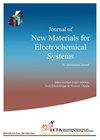羧甲基罗望子胶纳米粒子;作为一种抗氧化活性
IF 0.6
4区 材料科学
Q4 ELECTROCHEMISTRY
Journal of New Materials For Electrochemical Systems
Pub Date : 2023-08-25
DOI:10.14447/jnmes.v26i3.a01
引用次数: 0
摘要
将具有潜在抗氧化性能的生物聚合物纳米颗粒掺入用于人类健康护理的生物材料中具有重要意义。纳米羧甲基罗望子核胶(CMTKG)复合材料因其潜在的应用前景而成为当前研究的热点。采用共沉淀法制备了羧甲基罗望子核胶纳米粒子(CMTKG NPs)。该技术首次被用于制备羧甲基罗望子仁胶纳米颗粒。据报道,共沉淀和搅拌时间会影响纳米颗粒构象的强度。使用高分辨率透射电子显微镜(HR-TEM)、场发射扫描电子显微镜(FE-SEM)、傅立叶变换红外光谱(FTIR)、x射线衍射分析(XRD)和热重分析(TGA)对纳米颗粒进行表征。悬浮液颗粒尺寸已被确定为在40-60nm范围内。结果表明,类似的纳米颗粒可以用于抗氧化活性。本文章由计算机程序翻译,如有差异,请以英文原文为准。
Carboxymethyl Tamarind Kernel Gum Nanoparticles; As an Antioxidant Activity
The incorporation of biopolymer nanoparticles with potential antioxidant properties into biomaterials for human health care is significant. The current study focuses on nanoparticles carboxymethyl tamarind kernel gum (CMTKG) composite materials because of their potential applications. The co-precipitation method was used to create carboxymethyl tamarind kernel gum nanoparticles (CMTKG-NPs). This technique was used for the first time to create carboxymethyl tamarind kernel gum nanoparticles. The strength of nanoparticle conformation is reported to be influenced by co-precipitation and stirring time. Nanoparticles were characterised using high-resolution transmission electron microscopy (HR-TEM), field emission scanning electron microscopy (FE-SEM), fourier transform infrared (FTIR), x-ray diffraction analysis (XRD), and thermo-gravimetric analysis (TGA). Suspense particle sizes have been determined to be in the 40-60 nm range. It was concluded that similar nanoparticles could be used in antioxidant activities.
求助全文
通过发布文献求助,成功后即可免费获取论文全文。
去求助
来源期刊

Journal of New Materials For Electrochemical Systems
ELECTROCHEMISTRY-MATERIALS SCIENCE, MULTIDISCIPLINARY
CiteScore
1.90
自引率
0.00%
发文量
33
审稿时长
>12 weeks
期刊介绍:
This international Journal is intended for the publication of original work, both analytical and experimental, and of reviews and commercial aspects related to the field of New Materials for Electrochemical Systems. The emphasis will be on research both of a fundamental and an applied nature in various aspects of the development of new materials in electrochemical systems.
 求助内容:
求助内容: 应助结果提醒方式:
应助结果提醒方式:


